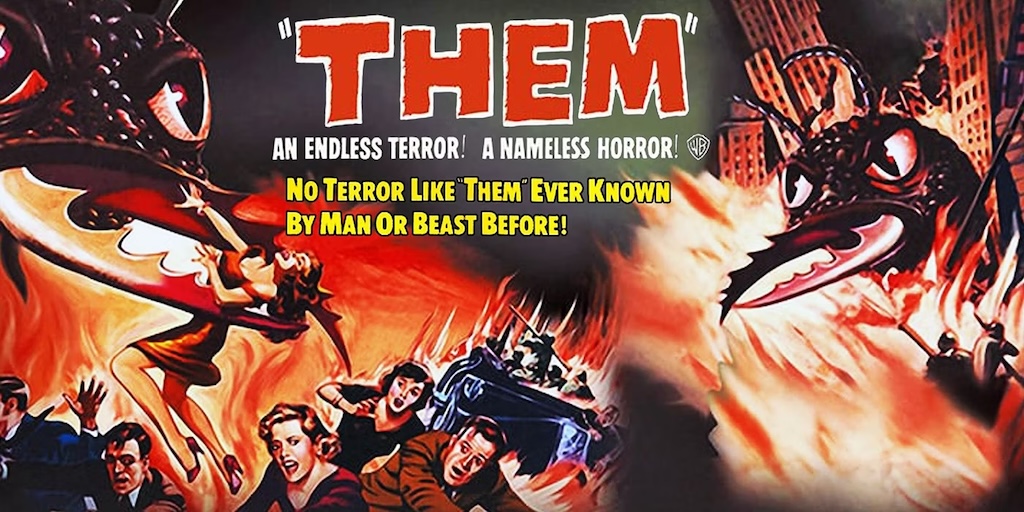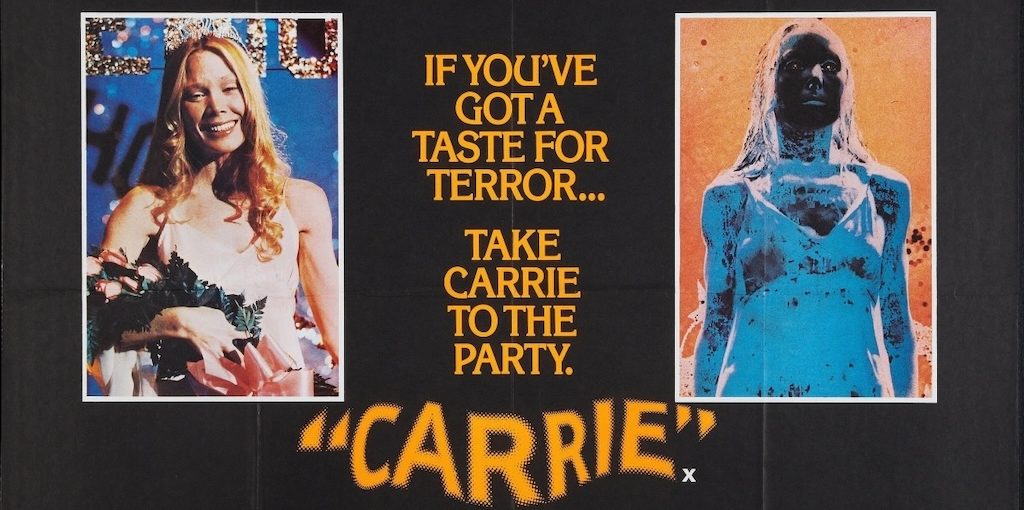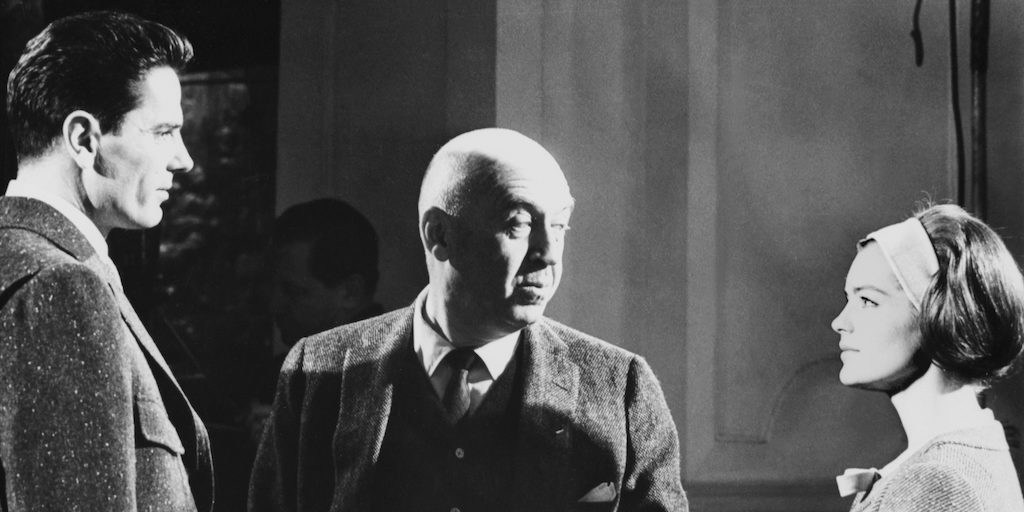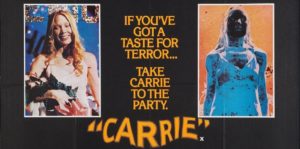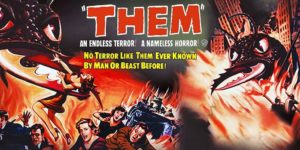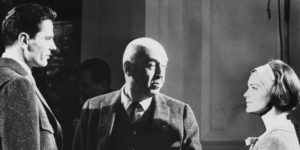THE CANON OF CINEMA
This article marks the beginning of a series of contributions featuring diverse contents the author considers might be of interest of those who share the taste for cinephilia.
FANTASY CINEMA (I): 1950’s Science Fiction
The wide concept of “Fantasy Cinema” tends to encompass a diverse group of film works that, as its name indicates, contain some element of fantasy. In its broadest sense involves quite a big number of films that have in common events, characters and/or imaginary creatures that do not belong to the reality known to us. Those fantasy worlds are very diverse, giving way to a subdivision in three major genres: science fiction, horror and a rather diffuse third we could just call adventure fantasy cinema.
The 1950’s shall remain in film history as the decade where basically anglophile countries (USA, Great Britain) developed in a rather random manner a wide panoply of film productions, ignoring they would remain in the audience’s popular memories.
The beginning of the decade
Although chronologically Irving Pichel’s Destination Moon, produced by George Pal, should be the first stop in this journey through the 1950’s it is not exactly a science fiction film, but a discreet account anticipating what would happen 18 years later.
Probably it would be The Day the Earth Stood Still in 1951 the first hit of the decade. The subject of nuclear strike drills breaks in, an usual matter during that time which could affirm served as an inspiration to many of the movies that marked the growth and peak of science fiction cinema. In the plot of Robert Wise’s film it was the sliding of warning message by the main character (portrayed by Michael Rennie) to Earth inhabitants and the famous three words including his name (Klaatu barada nikto).
Being released some months earlier, The Thing (From Antoher World) is another substantial title that came early in the decade, although many claim the more modern version by John Carpenter to be superior. In the 1951 version the one taking the directing credit is the unknown Christian Nyby, but it is widely known that behind him was a big figure such as Howard Hawks, who only gets a producer credit.
When Worlds Collide should not go unmentioned. Released in USA in November 1951. A typical B-product, and that includes its director, Rudolph Maté. His name however stands out as a major cinematographer (Gilda, Cover Girl ––both with Rita Hayworth–, To Be or Not to Be, Foreign Correspondent, etc.) When Worlds Collide was an upsetting story where astronomers find out that in a few months planet Zyra and star Bellus would end up, by collision, destroying Earth.
Enter Jack Arnold
It would be Jack Arnold, another worthy representative of American B-movies, who would dabble in half a dozen opportunities within the fantasy genre starting in 1953.
They were low budget productions (typical of Universal Studios at that time) featuring actors with hardly any glamour that seen today awakes a certain kind of cinephile pleasure.
It Came from Outer Space (in 3D) opens his series. Based on a short story by Ray Bradbury, in which an alien ship lands in the Arizona desert because of a mechanical malfunction without any destructive purposes. This traces it back to the above mentioned film by Robert Wise.
In a consecutive manner, Arnold with his fourth and fifth feature changed the tone a bit with Creature from the Black Lagoon and its first sequel, both in 3D (a major novelty back at the time). The creature, half man-half fish, provokes one than another death, but will give in to the attractive Julie Adams. Beautiful underwater scenes and a score by Henry Mancini highlight this worthy representative of B-Cinema.
The primitive technical resources of Tarantula and its black and white cinematography do not minimize the shivers still produced to this day upon the watching of a film where a science experiment transforms the title arachnid into a gigantic tarantula. The squad of jet fighters with which is attacked at the end (with napalm) is led by an “unknown” actor by the name of Clint Eastwood.
1957 The Incredible Shrinking Man is practically a mirror image of the latter, where a radioactive cloud (typical resource of the decade) produces the reverse effect of the previously mentioned film on the main character. He will have to face formidable enemies of large sizes against his tiny and decreasing dimension (hence the “Shrinking” in the title) and where once again a spider (a normal sized one) will be a fearsome threat.
Previous to the two films already mentioned and a probable source of inspiration, especially the former, it bears mentioning Them! where radioactivity once again is responsible for the major growth of another animal species: ants. The desert landscapes repeat themselves and start when two agents in Alamogordo (a nuclear test site) find a terrified girl, who describes the gigantic insects she has seen, and together set out to find them. It is probably the best title (and the only redeemable one) by Gordon Douglas, although for Warner Bros. it meant its biggest box office hit in 1954.
Enter Val Guest
Surely his name might sound unfamiliar since in the extensive filmography of this British director (over 50 credited features) there is not a whole lot to redeem. However, celebrated studio Hammer Films, whose fame answers above all to horror films starring Peter Cushing and Christopher Lee under the directing of Terence Fisher, had Guest also as a frequent helmer, starting in 1957.
One of Hammer’s first box office hits is quite previous and is based upon a successful 1953 BBC television series by Nigel Kneale. Upon being adapted into the format of a feature and seeking to widen their audiences to include American moviegoers they decided to hire Brian Donlevy, an Irish-born actor who was raised in America.
1955 The Quartermass Xperiment, released in America as The Creeping Unknown, deliberately used the penultimate letter in the alphabet to emphasize the “X” rating (adults only) ruling in the USA. As it was expected, in Argentina was known with the hardly imaginative title of Panico Mortal (“Deadly Panic”. Guest’s next film known in Argentina, The Weapon, would share a similar fate and was titled Cita Mortal, “Deadly Date”).
Professor Quartermass, who in the plot is the one who puts the first Englishman in space, researches the mysterious changes suffered by the mission’s only survivor since his return. The astronaut (Richard Wordsworth) will be decomposing upon being possessed by an alien force and contaminating other humans until being electrocuted by Quartermass in Westminster Abbey.
Quartermass II, released in 1957 in the USA as Enemy from Space and known in Argentina as Vasallos del Mal (Vassals of Evil) is even more spectacular not only for the suspense it generates but for the evil plans of aliens that, like with the first entry, planned to take possession of human beings, even within the “corrupt” British government. In the beginning, Quartermass (once again portrayed by Brian Donlevy) discovers a mysterious invasion of meteorites that transport the alien parasites. They have transformed an old refinery into an alleged food factory where in fact what is being produced are substances that will assist in the feared invasion.
This sequel keeps some kind of similitude with a film released a year earlier and that deserves to be added as to constitute a trilogy of the best science fiction cinema of the 1950’s and, dare we say it, the history of fantasy cinema as a whole.
By this we mean Don Siegel’s Invasion of the Body Snatchers, which had several remakes released under different titles in Spanish speaking territories. The very first was released as Muertos Vivientes and continues to be the best and very likely unsurpassable despite most members of its cast are not precisely famous. Kevin McCarthy and Dana Wynter constitute the lead couple, who discover the existence of pods that when opened show some beings in elaboration that are perfect replicas of humans that they will replace. They will do so by absorbing the victims’ minds while they are sleeping. The film was interpreted by some critics as an anti-communist statement in the McCarthy era, which happens to be a namesake of the lead actor.
The later years of the decade
1958 kept some kind of continuity with two new releases, proper exponents of B-Movies, directed by little known filmmakers.
First came German-born Kurt Neumann, so far known for several films of the previous decade in which Johnny Weismuller portrayed Tarzan. In the year of his demise Neumann directed his most accomplished work, The Fly, superbly shot in Cinemascope. A scientist performs experiments to make matter disintegrate within some sort of cabin, to later be retrieved in another similar cabin. When he decides to perform the experiment on himself he does not notice that a fly went in, resulting in two creatures, a man with a fly’s head and vice versa. It had a good remake, directed by David Cronenberg and starring Jeff Goldblum in the role of the scientist.
Two months later came The Blob, from the unknown Irvin S. Yeaworth. It starts when a meteor crashes in a rural zone, bringing with it a protoplasmic substance that begins to grow and engulf people. It was Steve McQueen’s first lead part and the main song, co-written by Burt Bacharach, turned out to be a big hit. It had a sequel and a remake, both best left forgotten.
The closing the decade saw the release of a very disquieting and apocalyptic film, Stanley Kramer’s On the Beach (known in Argentina as La Hora Final, “The Final Hour”). The lead part went to Gregory Peck, who portrayed the commander of a submarine arriving in Australia when a nuclear war in the northern hemisphere has destroyed part of mankind while the radioactive cloud heads towards south. It has a notable cast, including Ava Gardner, Fred Astaire and Anthony Perkins, in a film that awoke great anguish back in the day, given the context of the Cold War.
Jules Verne
It would be unfair to conclude this article without mentioning this great French author, whose most celebrated adaptations were all released in the 1950’s.
20,000 Leagues Under the Sea was released in 1954 by Walt Disney Pictures (Buena Vista), making it one of the first films shot in Cinemascope, featured a major cast and was directed by Richard Fleischer.
Two years later came the release of Around the World in 80 Days, not necessarily a science fiction film, that was even more successful in the box office (it doubled its earnings) and held fifth place when taking account the decade as a whole. It was directed by Michael Anderson and won the Oscar for Best Picture. It had almost a hundred cameos, featuring an unforgettable David Niven as Phileas Fogg, Cantinflas as Passepartout and Shirley MacLaine as an exotic princess.
Byron Haskin’s From the Earth to the Moon, released in 1958 and Henry Levin’s Journey to the Center of the Earth, released in 1959, close the quartet of Verne’s best novels, although in both cases the resulting films did not keep up with the legacy of the literary gems they were based upon.
Addendum
Not being either an American or an English production, it is however logic to mention another exponent of 1950’s science fiction cinema. Its origin is Japanese and its name in that language answers to Gojira, a term that comes from the merging of two Japanese words that mean (in that order) “gorilla” and “kujira” (whale). Released in 1954 in its country of origin, it was directed by Inoshiro Honda. In America it was reedited (actor Raymond Burr makes an appearance) and it was known as Godzilla King of the Monsters, and it was released in Argentina under the same title (Godzilla, rey de los monstruos). The 400 feet monster is awoken in the sea by an atomic bomb, to later spread fear in the city of Tokyo. Its producer, Tomoyuki Tanaka, was inspired by an animated monster, product of the great Ray Harryhausen (for Eugene Lourie’s The Beast from 20,000 Fathoms). Unlike the majority of monsters, Godzilla was not animated (budgetary issues) but portrayed by actors (Tanaka himself) using a leather costume. The first entry was shot in black and white while its diverse sequels were shot in color.
TOP FIVE
Out of the twenty films reviewed here and set to choose those who might integrate a canon of 1950’s science fiction, the following five titles are proposed for consideration, in order of first release:
THE DAY THE EARTH STOOD STILL (1951)
THEM! (1954)
INVASION OF THE BODY SNATCHERS (1956)
THE INCREDIBLE SHRIKING MAN (1957)
QUARTERMASS II/ENEMY FROM SPACE (1957)
SELECTED BIBLIOGRAPHY
BOUYXOU, J.P.,(1971), La sciecne-fiction au cinéma, 10/18, Paris
CURUBETO, Diego (colab. de KAIRUZ M., ORTA, M., (2019), Cine Bizarro, Mansalva, Argentina
GASCA, Luis. (1975), Cine y ciencia ficción, Editorial Planeta, España
HARDY, PHIL. (1984), The Encyclopedia of Science Fiction Movies, Woodbury Press, USA
HUNTER, I.Q. (1999), British Science Fiction Cinema, Rutledge, London
EYLES, A., ADKINSON, R., FRY, B. (1973), House of Horror – The Complete Hammer Films, London
FRIEDLANDER, F., VILLANUEVA, A. (2022), El Canon del cine norteamericano – Vol.1, ASL Ediciones.
THE CANON OF AMERICAN CINEMA. VOLUME 1: FROM SILENT CINEMA TO 1959 can be purchased in this link.

